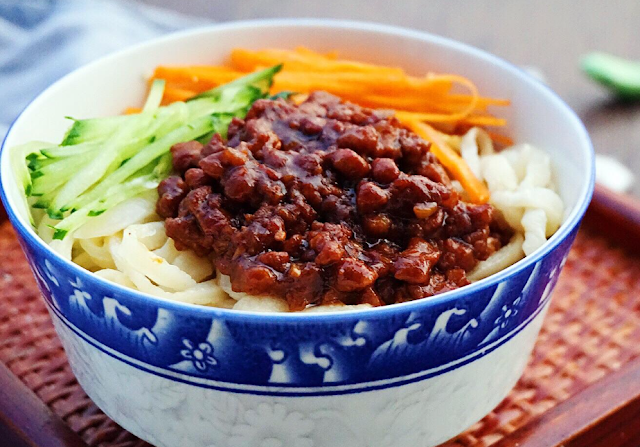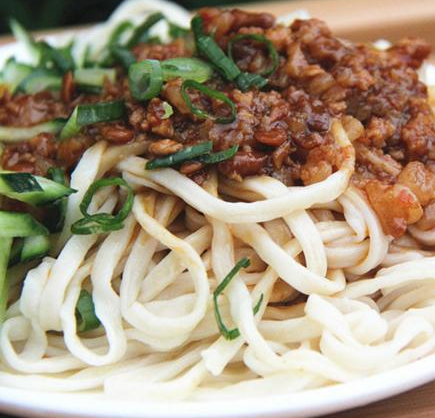About Zha Jiang Mian
Zha Jiang Mian is a conventional Beijing-style noodle dish and is taken into account one of many “Prime Ten Noodles in China”. It’s made by mixing the “vegetable code” and “fried sauce” with noodles.

About Zha Jiang
Whether or not it is yellow sauce or candy bean sauce, they’re all fermented merchandise, with a particular odor that must be dry-fried over low warmth to take away. Making Zha Jiang requires “dry-frying in a small bowl”. If you happen to make an excessive amount of without delay, the sauce won’t be fried completely and will not be crispy. Dry-fry over low warmth, and don’t add water within the center. Together with the evaporation of the moisture contained in the sauce, it’s a technique of mixing the sauce with diced meat.

To make Zha Jiang, select fatty pork stomach and separate the fats from the lean. Minimize it into diced, not minced, items. The diced meat shouldn’t be too small, or it can grow to be too dry when fried and will not style good. Additionally it is vital so as to add fragrant spices akin to scallions and ginger to boost the flavour. The sauce is often made by mixing yellow sauce and candy bean sauce, with the ratio relying on private choice. Yellow sauce provides freshness, whereas candy bean sauce provides taste. Some individuals like solely yellow sauce, whereas others favor solely candy bean sauce.
As time passes, the warmth ought to be good. The fatty pork comes with its personal oil and shall be delicate and moist, whereas the lean pork shall be fragrant. A professional Zha Jiang ought to be fried over low warmth till the oil and sauce separate. Through the use of chopsticks to separate the sauce, the oil won’t stick, leading to a real and excellent mixture of sauce and meat. The sauce ought to be wealthy in meaty perfume, and the meat ought to be coated with a wealthy and full sauce.

Concerning making noodles
The noodles used for Zha Jiang Mian enchantment to individuals of all backgrounds, as they are often tough or delicate, widespread or elegant. Hand-pulled noodles are probably the most conventional and genuine, however they require a sure stage of talent, which takes not less than three to 5 years to grasp. In distinction, hand-rolled noodles had been extra lately accepted by individuals and are comparatively easy and straightforward to deal with.
One other sort of noodle-making method is called “Jiu Pian Er,” the place the noodles produced are uneven in thickness, including a singular texture to the general dish. Whatever the methodology, the cooked noodles ought to be translucent, clean, and pliable, with good elasticity. These days, individuals have a tendency to make use of machine-made noodles at dwelling or buy contemporary noodles which might be ready-to-cook.

Concerning the vegetable toppings for Zha Jiang Mian
The vegetable toppings, often known as “Cai Ma,” for Zha Jiang Mian may be so simple as a cucumber or a clove of garlic, or as complicated as seven or eight various kinds of greens ready in numerous methods. The most typical greens used embrace cucumbers, carrots, and bean sprouts, whereas water radish, scallions, celery, cabbage, soybeans, and Chinese language toon leaves are additionally in style choices.
The important thing precept is to decide on the freshest and most scrumptious greens out there. Vegetable toppings may be labeled as “Ming Ma” – the seen toppings, and “An Ma” – the hidden toppings that require blanching. “An Ma” is boiled and blended with the noodles and sauce, whereas “Ming Ma” is served on high of the noodles and sauce to protect its freshness and crunchiness.
Lastly, just a few cloves of garlic are added to boost the flavour of the dish, which enhances the richness of the sauce. Garlic is the right crowning glory to Zha Jiang Mian.

Now let’s make zha jiang mian
Substances:
Noodles: 500g flour, 200g water, 3g salt, 1.5g food-grade alkaline, 1 egg white (alter the quantity in line with the variety of individuals)
Sauce: 50g vegetable oil, 500g pork stomach, 200g fermented soybean paste, 100g scallion and ginger water, 100g cooking wine, 100g candy bean paste, 2-star anise, 50-75g sugar, a small quantity of floor pepper, 2g MSG or hen powder (non-obligatory), 100g scallions, and 50g ginger.
Vegetable toppings: Cucumber, celery, garlic, carrots, bean sprouts, and so on. (select in line with private choice)
Steps:
1. Combine 200g of water, 3g salt, 1.5g food-grade alkaline, and 1 egg white, then pour right into a mixing bowl. Add 500g of flour and stir till it resembles cotton. Use a noodle maker with a handbook rolling perform, or roll the dough by hand. If rolling by hand, knead the dough right into a clean and constant texture, then let it relaxation for half-hour.
Sprinkle an appropriate quantity of dry flour on the board to forestall sticking. Flatten the dough and use a rolling pin to create a thick pancake-like form. After spreading it out, sprinkle dry flour on it to forestall sticking, then roll it up and repeat a number of occasions to make a pancake with an appropriate thickness.
Stack the pancakes on high of one another and reduce them into appropriate thickness of noodles. Sprinkle dry flour on it to forestall sticking.

2. Select high-quality pork stomach and separate the fatty and lean components. Minimize them into 0.5 cm sq. cubes. If they’re too skinny, they could grow to be too dry when fried, affecting the style.

3. Finely chop the scallions and ginger into small items.

4. Add 200g of dried yellow soybean paste, 100g of minced scallion and ginger water, and 100g of cooking wine in a 1:1 ratio of sauce to water. Convey it to a boil. Put together 100g of candy bean sauce. If contemporary yellow soybean paste is used, the method shall be comparatively simpler.

5. The essence of Zha Jiang Mian lies solely within the sauce, and the chef will educate you make certified Zha Jiang. Do not make errors once more. Pour 50 grams of vegetable oil into the pot, warmth the pot with the cool oil, add diced fatty pork first, stir-fry over low warmth till aromatic and crispy. Then add the diced lean pork, stir-fry till aromatic and cooked by way of. Add two star anise, stir-fry till aromatic, then add finely chopped ginger and scallions, stir-fry till aromatic, and the aroma is wealthy.

6. Add within the well-stirred yellow sauce and candy bean sauce, and fry over low warmth. Using the volatilization of cooking wine within the yellow sauce, it removes the bean odor from the yellow sauce, and your complete technique of sluggish frying over low warmth is important to fry it aromatic and completely, which takes about 30–40 minutes. Preserve stirring to forestall sticking to the underside of the pot. Because the water vapor within the sauce evaporates, oil and sauce will ultimately separate. Use chopsticks to interrupt open the sauce within the center, and the oil and sauce won’t stick collectively, reaching a real mixture of meat and sauce. The fried sauce is then executed. Add 50–75 grams of sugar, a small quantity of pepper, and a couple of grams of monosodium glutamate or hen powder (non-obligatory) for seasoning. One can not end the fried sauce in a single meal. After placing the sauce in a bowl and overlaying it with plastic wrap, it may be eaten for as much as three days after being refrigerated. When consuming, re-fry it in a pan.

7. Put together the diced greens.

8. Combine the diced greens that must be blanched, noodles, and fried sauce evenly, after which high it off with a layer of crispy diced greens. That is the second to benefit from the deliciousness.
#essence #Zha #Jiang #Mian #chef #teaches #certified #Zha #Jiang #dont #errors
